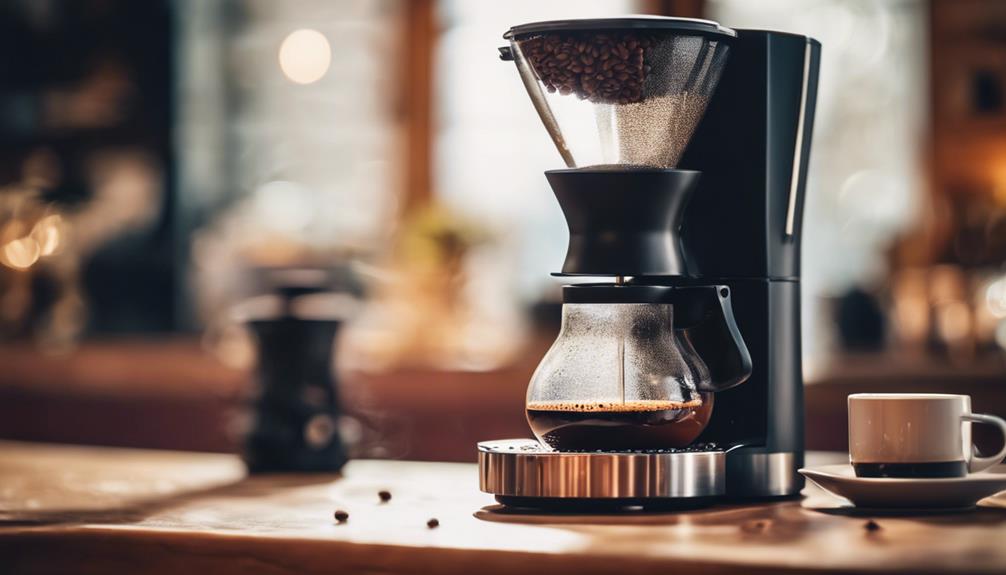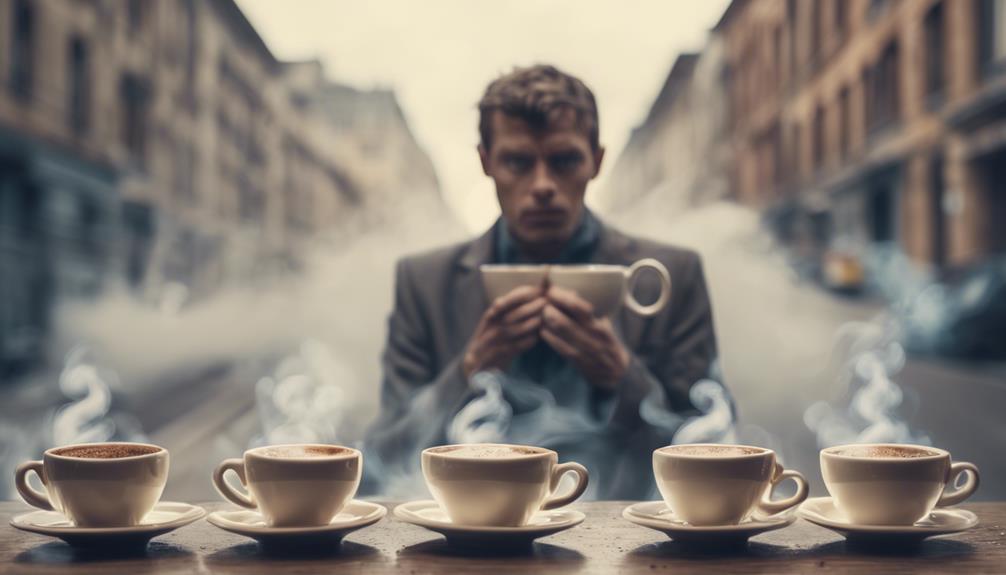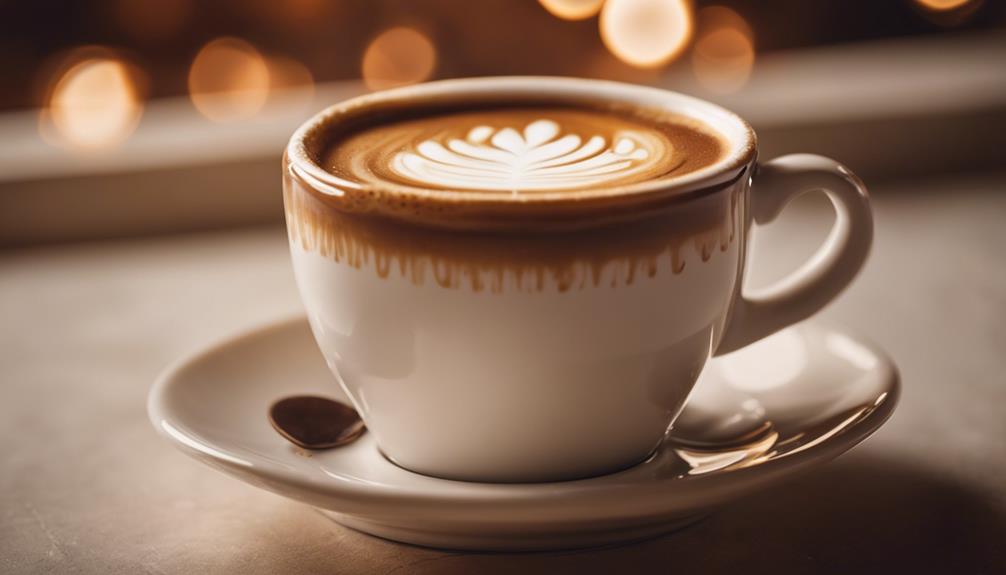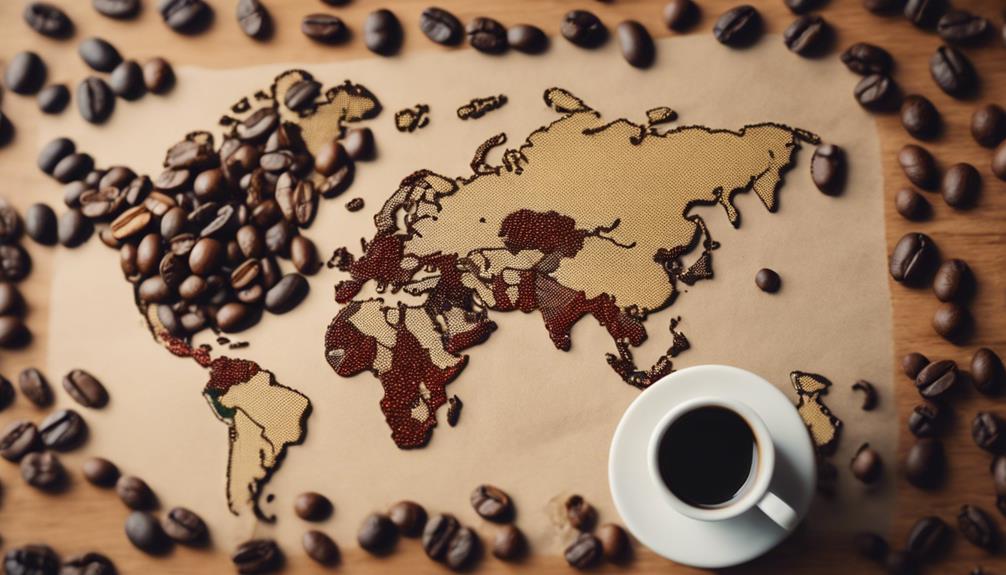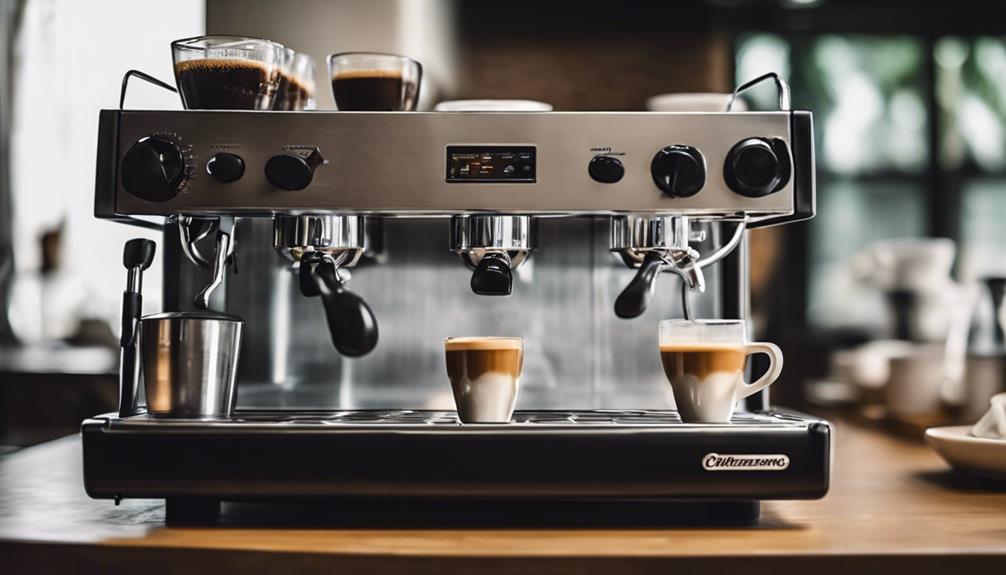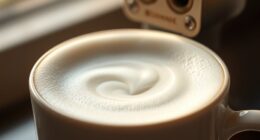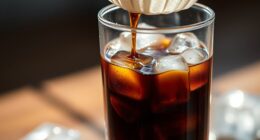In espresso, a single shot uses 7g of coffee, yielding 30ml, while a double shot has 14g, yielding 60ml. Your choice depends on strength preference. Grinding precision impacts flavor and strength. Shots should brew for 25-30 seconds. Extraction differs based on coffee amount. Single shots hold 30-50mg caffeine, doubles have 60-100mg. Accuracy is key. Baristas focus on consistency with precise measurements. Water, pressure, and grind uniformity play an essential role. Crafting each shot guarantees a satisfying experience. Further insights await on perfecting the art of espresso making.
Key Takeaways
- Single shot: 7g coffee, 30ml volume, intense flavor.
- Double shot: 14g coffee, 60ml volume, balanced taste.
- Choice based on preference and strength desired.
- Single shot stronger, double shot more balanced.
- Understanding difference aids in serving preferences.
Espresso Shot Basics
When making espresso shots, the basic difference between a single and double shot lies in the amount of coffee used and the resulting drink volume. A single shot of espresso typically contains 7g of coffee and yields around 30ml of the beloved strong brew.
On the other hand, a double shot, also known as a doppio, doubles the amount of coffee to 14g, resulting in a 60ml drink that packs a flavorful punch. The choice between a single or double shot often depends on personal preference and the desired strength of the espresso.
Single shots are ideal for those seeking a milder flavor, while doubles cater to those who crave a more intense coffee experience. It's fascinating to note the evolution of these espresso traditions, with lever espresso machines sparking the creation of single shots and doubles becoming the norm in most coffee establishments.
Whether you opt for a solo or a powerful doppio, each espresso shot offers a unique experience in every sip.
Coffee Grounds Comparison
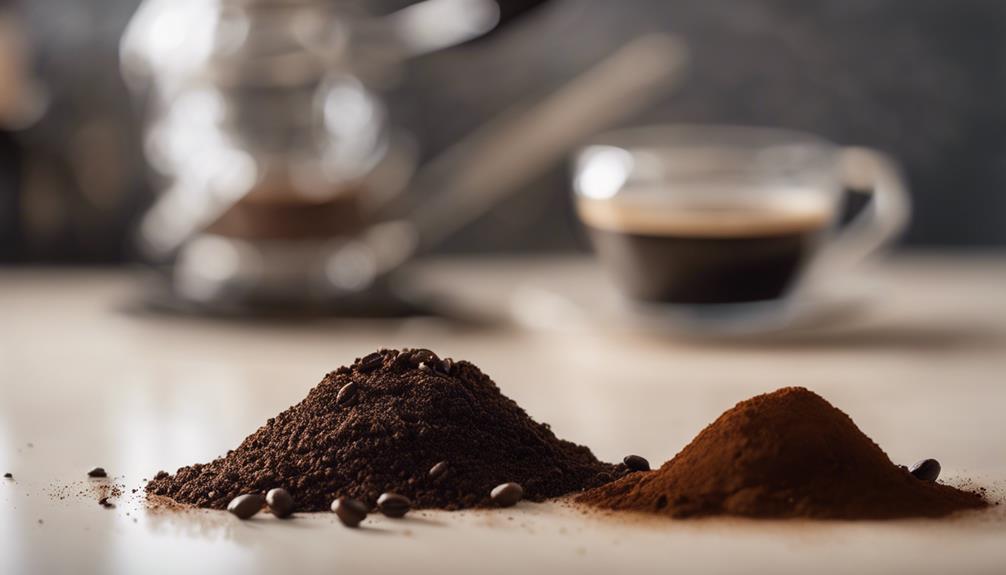
When comparing single and double shot espressos, the amount of coffee grounds used plays an essential role. Ground size greatly impacts the brewing time and ultimately affects the flavor extraction process. Understanding these factors is key to achieving the desired intensity and richness in your espresso shot.
Ground size greatly impacts the brewing time and ultimately affects the flavor extraction process.
Understanding these factors is key to achieving the desired intensity and richness in your espresso shot.
Ground Size Matters
Considering the importance of ground size in espresso preparation, a key distinction arises between single and double shot espressos.
For double espresso shots, the amount of coffee grounds used is notably higher compared to single shots. Single shot espressos typically require 7-9 grams of coffee grounds, while double shots demand 14-18 grams. This variance in ground size directly influences the flavor, strength, and intensity of the espresso produced.
Baristas meticulously measure and adjust the amount of coffee grounds to maintain consistency and quality in both single and double shot espressos. The precision in grinding and dosing is essential in ensuring the overall taste and experience of the espresso shot meets the desired standard.
Brewing Time Impact
The brewing time for both single and double espresso shots plays a significant role in extracting the desired flavors from the coffee grounds. Here's how the brewing time impacts your espresso experience:
- Consistent Extraction: Both single and double shots require a brewing time of 25-30 seconds to guarantee the flavors are properly extracted from the coffee grounds.
- Maintaining Balance: Keeping the brewing time consistent helps uphold the balance and intensity of the espresso, ensuring a harmonious flavor profile.
- Taste and Strength: Adjusting the brewing time can directly impact the taste and strength of your espresso, influencing its overall quality.
- Quality Control: Monitoring the brewing time closely is essential to make sure that your single or double shot espresso meets your desired standards regarding flavor and strength.
Flavor Extraction Variance
Understanding the difference in coffee grounds used for single and double shot espressos is essential for grasping the variance in flavor extraction between the two.
When comparing a single espresso, which typically consists of 7 grams of finely ground coffee, to a double shot of espresso, which uses 14 grams, the espresso ratios play a vital role in determining the flavor profile.
A double shot espresso, with its increased amount of coffee grounds, results in a more balanced and flavorful extraction. On the other hand, a single shot espresso, with its smaller dose of coffee grounds, tends to deliver a more intense and concentrated flavor experience.
Volume Output Variations
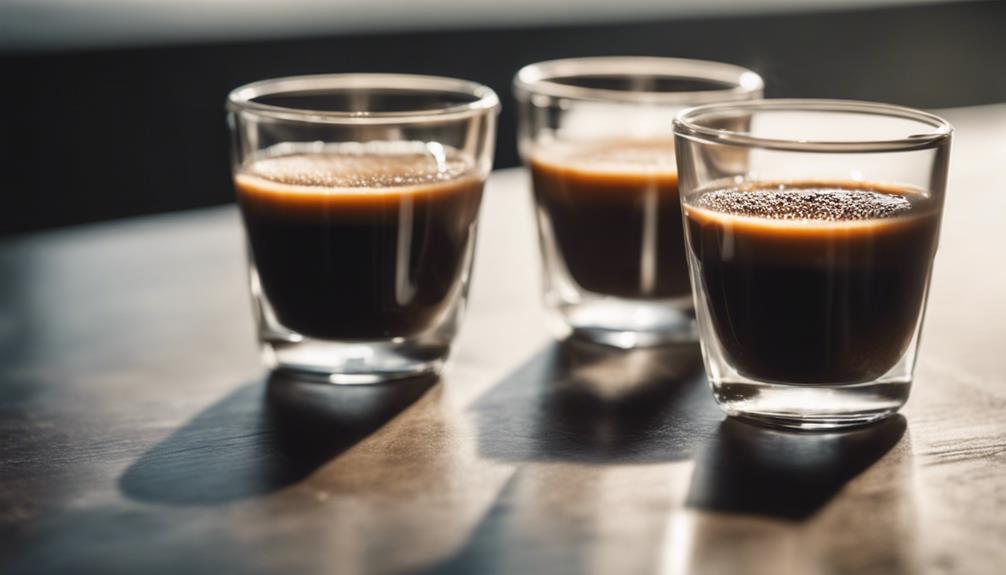
When comparing single and double shot espressos, you may notice a significant difference in the volume output. Here's why:
- Single shots are typically around 30ml, perfect for those looking for a quick pick-me-up or a milder caffeine boost.
- Double shots, on the other hand, yield about 60ml, offering a stronger and more robust flavor profile for those needing a bigger kick.
- Espresso machines are calibrated to deliver specific volumes for single and double shots, ensuring consistency in taste and quality.
- The extraction time for double shots is longer than for single shots, allowing for a more thorough extraction of flavors and aromas from the coffee grounds.
Understanding these volume variations is important for coffee enthusiasts and baristas alike, as it influences the strength, flavor, and overall experience of the espresso.
Whether you prefer the intensity of a double shot or the subtlety of a single shot, knowing the differences in volume output can help you appreciate and enjoy your espresso even more.
Caffeine Content Analysis
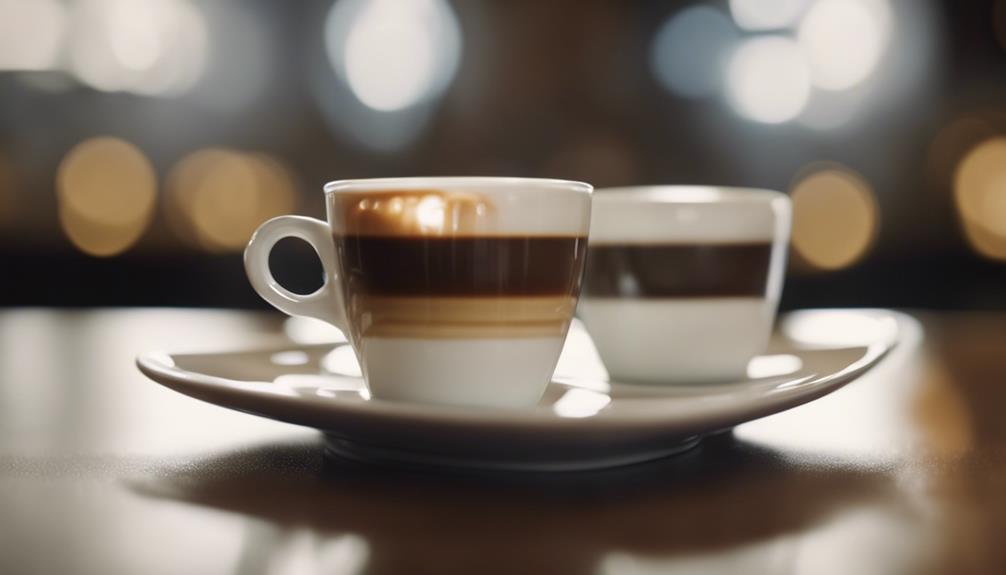
When comparing single and double shot espressos, understanding the caffeine concentration is essential for evaluating its impact on your energy levels.
A single shot typically contains 30-50mg of caffeine, while a double shot can have 60-100mg, potentially affecting your alertness differently.
Caffeine Concentration Comparison
Comparing the caffeine concentration between a single shot and a double shot of espresso reveals a significant difference in their caffeine content. Here are some key points to keep in mind:
- A single shot of espresso typically contains 30-50mg of caffeine, while a double shot can have 60-100mg.
- The caffeine content in espresso is influenced by the amount of coffee used, with traditional double shots having 60-100mg.
- Modern espresso ratios are measured by weight, not volume, impacting caffeine levels in shots.
- Precision in shot measurement is essential in specialty coffee to maintain consistent caffeine content.
Understanding these differences in caffeine concentration between single and double shots of espresso can help coffee enthusiasts make informed choices based on their caffeine preferences.
Whether you're looking for a milder boost or a stronger kick, knowing the caffeine content in each shot can guide your coffee selection for the day.
Impact on Energy Levels
Understanding the caffeine content in single and double shots of espresso directly impacts your energy levels throughout the day. A single shot typically contains 30-50mg of caffeine, while a double shot packs 60-100mg, influencing how alert you feel.
The amount of coffee beans used in the portafilter determines the caffeine levels in your espresso. Modern double shots, incorporating more coffee grounds, may have slightly higher caffeine levels than traditional doubles.
Managing your energy levels and consumption can be aided by knowing the caffeine content in different shots. Variations in shot recipes and ratios can also play a role in affecting the overall caffeine content in your espresso drinks.
Importance of Measurement Accuracy
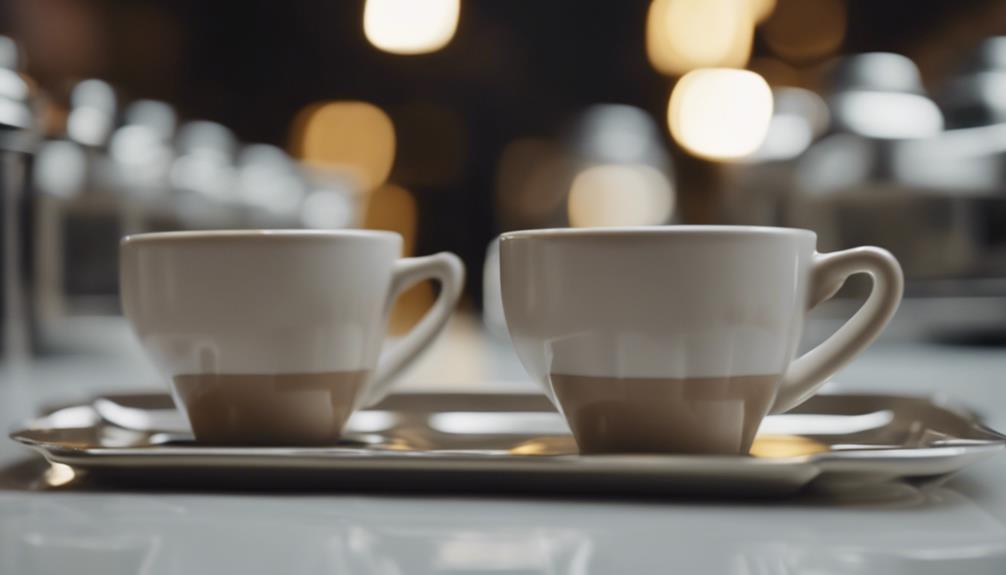
For a precise and consistent espresso experience, baristas prioritize weighing espresso shots to guarantee accuracy in measurement.
Here's why measurement accuracy is important for busy baristas in the modern coffee industry:
- Standard for Single Shot: By accurately measuring the amount of coffee grounds for a single shot, baristas establish consistency in flavor and strength.
- Making a Precise Modern Espresso: In the fast-paced environment of a modern coffee shop, precise measurements are necessary to meet customer expectations.
- Balancing Taste and Mouthfeel: The balance between the weight of the coffee grounds and the final beverage impacts the taste and mouthfeel of the espresso.
- Increasing Output Efficiency: With accurate measurements, baristas can manage brew ratios effectively, increasing output while maintaining quality.
Ensuring precise measurement accuracy not only replicates the desired flavor profile of the espresso but also plays a significant role in achieving a well-balanced and satisfying shot for every customer.
Barista Tips for Consistency
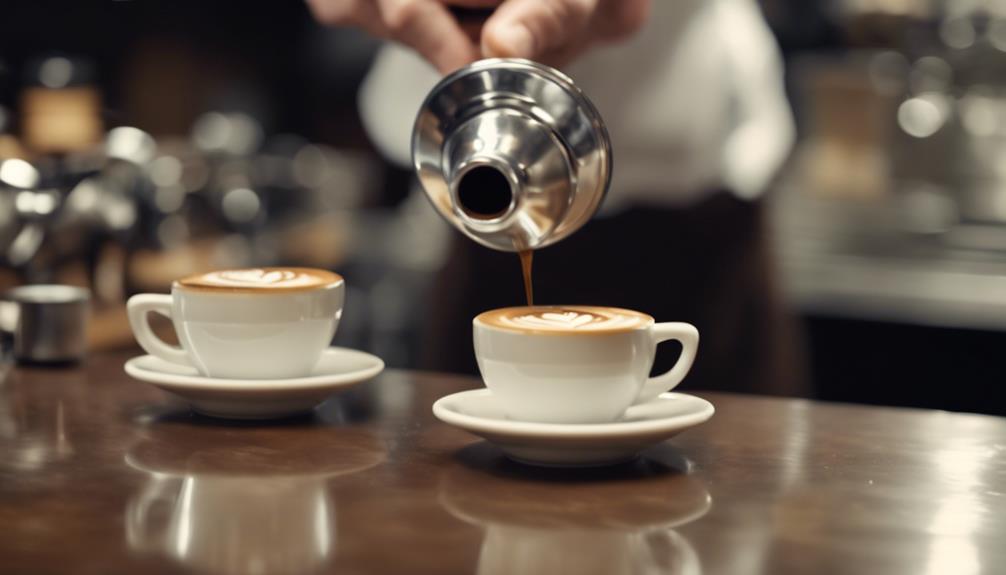
To guarantee consistent quality in your espresso shots, consider implementing these practical barista tips. In the world of espresso, shot consistency is key to delivering a high-quality product at your coffee shop. Start by using a scale to weigh coffee grounds accurately for precise shot extraction. This ensures that each shot has the right balance of flavor and strength.
Additionally, maintaining consistent water temperature and pressure is important in achieving shot consistency. By keeping these factors steady, you can replicate the same great taste in every shot you pull.
Another tip for baristas is to regularly calibrate your grinder to ensure a uniform grind size. This helps with even extraction, preventing any variations in flavor between shots. Pay attention to shot timing and flow rate as well, as these factors play a significant role in producing consistent single and double espresso shots.
Frequently Asked Questions
What Is the Difference Between a Single and Double Shot of Espresso?
A single shot of espresso contains 7g of coffee, yielding around 30ml of espresso. This shot typically has 30-50mg of caffeine.
A double shot uses 14g of coffee, producing approximately 60ml of espresso. A double shot contains 60-100mg of caffeine.
Understanding these differences helps you choose the right espresso based on your preferred flavor intensity and caffeine content.
Which Is Stronger, Single or Double Espresso?
A double espresso packs a stronger punch than a single, with double the caffeine content in a smaller volume. The difference lies in the amount of coffee used, where a double shot contains twice as much as a single.
If you're seeking a robust flavor and a jolt of energy, opt for the double shot. It's all about intensity and concentration in that tiny cup of goodness.
What Is the Difference Between Single and Double Espresso Cups?
When comparing single and double espresso cups, the key difference lies in the amount of coffee grounds and water used. A single espresso cup contains 30ml of espresso made with 7g of grounds, providing a more intense flavor.
In contrast, a double espresso cup holds 60ml of espresso with 14g of grounds, offering a richer taste.
The choice between single and double espresso depends on your preference for intensity and flavor.
What Is the Difference Between Single and Double Basket Espresso?
In espresso brewing, the difference between single and double basket shots lies in the amount of coffee used. Single baskets contain 7 grams for a single shot, while double baskets hold 14 grams for a double shot.
Double baskets are favored due to their ability to provide a more consistent extraction. This impacts the flavor profile, strength, and overall quality of your espresso.
Consider your preference for taste and strength when choosing between single and double basket espresso shots.
What is the Difference Between a Single and Double Shot Espresso and How Does it Affect the Flavor?
When it comes to espresso, the difference between a single and double shot lies in the amount of coffee used. A single shot typically contains 7-9 grams of coffee, while a double shot contains 14-18 grams. This impacts the flavor, as a double shot is stronger and more intense, which is why espresso shots are amazing for coffee lovers looking for a bold and rich taste.
What is the difference between a single and double shot of espresso and how does the volume affect it?
Understanding double espresso volume is crucial when discussing the difference between a single and double shot. A single shot typically contains around 1 ounce of espresso, while a double shot contains around 2 ounces. The volume affects the flavor and strength of the espresso, with a double shot being stronger and more intense.
Conclusion
Just as a single espresso shot offers a quick jolt of energy, while a double shot provides a more robust kick, the choice between the two ultimately comes down to personal preference and desired intensity.
Like two sides of the same coin, both options have their own unique qualities that cater to different tastes and needs.
So, whether you prefer a single shot for a milder experience or a double shot for a bolder flavor, the world of espresso is yours to savor.

